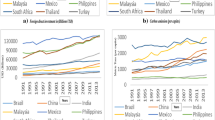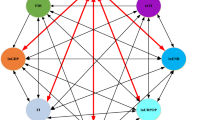Abstract
This research investigates the relationship between foreign direct investment, domestic credit to the private sector, energy supply and human capital on carbon emissions subject to the level of trade. In the interest of capturing this non-linear association, this paper utilises the fixed effect panel threshold model. Thus, deploying a panel dataset of BRICS economies from 2000 to 2018, the study produces important findings that trade exerts a considerable non-linear influence on environmental quality. In this context, the paper determines specific threshold levels upon which environmental quality either increase or decrease for the BRICS economies when either energy supply (1.5962, approximately $US 4.934 million), domestic credit to the private sector (1.6375, about $US 5.142 million), foreign direct investment (1.6375, about $US5.142 million) or human capital (1.6375, about $US5.142 million) increases. To ascertain the causation of included parameters, the Dumitrescu and Hurlin causality test results are also presented.
Similar content being viewed by others

Data availability
The datasets used and/or analysed during the current study are available from the corresponding author on reasonable request.
References
Acheampong AO (2019) Modelling for insight: does financial development improve environmental quality? Energy Econ 83:156–179
Ahmad A, Zhao Y, Shahbaz M, Bano S, Zhang Z, Wang S, Liu Y (2016) Carbon emissions, energy consumption and economic growth: an aggregate and disaggregate analysis of the Indian economy. Energy Policy 96:131–143
Al-mulali U, Sab CNBC (2012) The impact of energy consumption and CO2 emission on the economic and financial development in 19 selected countries. Renew Sust Energ Rev 16(7):4365–4369
Aydin L (2016) Intra-BRICS trade opening and its implications for carbon emissions: a general equilibrium approach. J Econ Dev Stud 4(2):207–218
Aydin C, Esen Ö (2018) Reducing CO2 emissions in the EU member states: do environmental taxes work? J Environ Plg Manage 61(13):2396–2420
Aye GC, Edoja PE (2017) Effect of economic growth on CO2 emission in developing countries: evidence from a dynamic panel threshold model. Cogent Econ Financ 5(1):1379239
Bano S, Zhao Y, Ahmad A, Wang S, Liu Y (2018) Identifying the impacts of human capital on carbon emissions in Pakistan. J Clean Prod 183:1082–1092
Baz K, Xu D, Ali H, Ali I, Khan I, Khan MM, Cheng J (2020) Asymmetric impact of energy consumption and economic growth on ecological footprint: using asymmetric and nonlinear approach. Sci Total Environ 718:137364
Belucio M, Lopes C, Fuinhas JA, Marques AC (2019) Energy–growth nexus, domestic credit, and environmental sustainability: a panel causality analysis. In: The Extended Energy-Growth Nexus. Academic Press 173-197
Boutabba MA (2014) The impact of financial development, income, energy and trade on carbon emissions: evidence from the Indian economy. Econ Model 40:33–41
CAIT (2017) CAIT climate data explorer. Washington DC: World Resources Institute
Cheikh NB, Zaied YB, Chevallier J (2021) On the nonlinear relationship between energy use and CO2 emissions within an EKC framework: evidence from panel smooth transition regression in the MENA region. Res Int Bus Financ 55:101331
Cheng C, Ren X, Wang Z, Yan C (2019) Heterogeneous impacts of renewable energy and environmental patents on CO2 emission-evidence from the BRIICS. Sci Total Environ 668:1328–1338
Dai F, Yang J, Guo H, Sun H (2021) Tracing CO2 emissions in China-US trade: a global value chain perspective. Sci Total Environ 775:145701
Du WC, Xia XH (2018) How does urbanization affect GHG emissions? A cross-country panel threshold data analysis. Appl Energy 229:872–883
Du K, Yu Y, Li J (2020) Does international trade promote CO2 emission performance? An empirical analysis based on a partially linear functional-coefficient panel data model. Energy Econ 92:104983
Dumitrescu EI, Hurlin C (2012) Testing for Granger non-causality in heterogeneous panels. Econ Model 29(4):1450–1460
Ganda F (2018) Carbon emissions, energy consumption and economic growth in Zimbabwe: investigating the existence of the environmental Kuznets curve within a developing economy context. Int J Sustain Econ 10(3):226–248
Ganda F (2019) The environmental impacts of financial development in OECD countries: a panel GMM approach. Environ Sci Pollut Res 26(7):6758–6772
Ganda F (2021) The influence of growth determinants on environmental quality in Sub-Saharan Africa states. Environ Dev Sustain 23(5):7117–7139
Granger CW (1969) Investigating causal relations by econometric models and cross-spectral methods. Econom 37:424–438
Halliru AM, Loganathan N, Hassan AAG, Mardani A, Kamyab H (2020) Re-examining the environmental Kuznets curve hypothesis in the Economic Community of West African States: a panel quantile regression approach. J Clean Prod 276:124247
Hanif I, Raza SMF, Gago-de-Santos P, Abbas Q (2019) Fossil fuels, foreign direct investment, and economic growth have triggered CO2 emissions in emerging Asian economies: some empirical evidence. Energy 171:493–501
Hansen BE (1999) Threshold effects in non-dynamic panels: estimation, testing, and inference. J Econ 93(2):345–368
Hansen BE (2017) Regression kink with an unknown threshold. J Bus Econ Stat 35(2):228–240
Hao LN, Umar M, Khan Z, Ali W (2021) Green growth and low carbon emission in G7 countries: how critical the network of environmental taxes, renewable energy and human capital is? Sci Total Environ 752:141853
Hassan ST, Baloch MA, Tarar ZH (2020) Is nuclear energy a better alternative for mitigating CO2 emissions in BRICS countries? An empirical analysis. Nucl Eng Technol 52(12):2969–2974
International Panel on Climate Change (1996) IPCC Second Assessment on Climate Change. Cambridge University Press, Cambridge, UK
International Trade Centre (2017) BRICS countries: emerging players in global services trade, ITC, Geneva
Kais S, Sami H (2016) An econometric study of the impact of economic growth and energy use on carbon emissions: panel data evidence from fifty-eight countries. Renew Sust Energ Rev 59:1101–1110
Kirton J (2020) BRICS Climate Governance in 2020. http://wwwbricsutorontoca/biblio/Kirton_BRICS_Climate_Governance_2020html Accessed 12 May 2021
Kozul-Wright R, Fortunato P (2012) International trade and carbon emissions. Eur J Dev Res 24(4):509–529
Li G, Wei W (2021) Financial development, openness, innovation, carbon emissions, and economic growth in China. Energy Econ 97:105194
Lin B, Li Z (2020) Is more use of electricity leading to less carbon emission growth? An analysis with a panel threshold model. Energy Policy 137:111121
Liobikienė G, Butkus M (2019) Scale, composition, and technique effects through which the economic growth, foreign direct investment, urbanization, and trade affect greenhouse gas emissions. Renew Energy 132:1310–1322
Lopez L, Weber S (2017) Testing for Granger causality in panel data. Stata J 17(4):972–984
Lu Q, Fang K, Heijungs R, Feng K, Li J, Wen Q, Li Y, Huang X (2020) Imbalance and drivers of carbon emissions embodied in trade along the Belt and Road Initiative. Appl Energy 280:115934
Mahalik MK, Villanthenkodath MA, Mallick H, Gupta M (2021) Assessing the effectiveness of total foreign aid and foreign energy aid inflows on environmental quality in India. Energy Policy 149:112015
Majeed MT, Mazhar M (2019) Financial development and ecological footprint: a global panel data analysis. Pak J Commer Soc Sci 13(2):487–514
Maryam J, Mittal A, Sharma V (2017) CO2 emissions, energy consumption and economic growth in BRICS: an empirical analysis. J Human Soc Sci 22(2):53–58
Mirza FM, Kanwal A (2017) Energy consumption, carbon emissions and economic growth in Pakistan: dynamic causality analysis. Renew Sust Energ Rev 72:1233–1240
Mosikari TJ, Eita JH (2020) CO2 emissions, urban population, energy consumption and economic growth in selected African countries: a panel smooth transition regression (PSTR). OPEC Energy Rev 44(3):319–333
Mukhlis M (2020) The causality between human capital, energy consumption, CO2 emissions, and economic growth: empirical evidence from Indonesia. Energy Consumption, CO2 Emissions, and Economic Growth: Empirical Evidence from Indonesia (June 13, 2020)
Munksgaard J, Pade LL, Minx J, Lenzen M (2005) Influence of trade on national CO2 emissions. Int J Glob Energy Issues 23(4):24–336
Ouyang X, Shao Q, Zhu X, He Q, Xiang C, Wei G (2019) Environmental regulation, economic growth and air pollution: panel threshold analysis for OECD countries. Sci Total Environ 657:234–241
Rahman ZU, Ahmad M (2019) Modeling the relationship between gross capital formation and CO2 (a) symmetrically in the case of Pakistan: an empirical analysis through NARDL approach. Environ Sci Pollut Res 26(8):8111–8124
Rahman MM, Kashem MA (2017) Carbon emissions, energy consumption and industrial growth in Bangladesh: empirical evidence from ARDL co-integration and Granger causality analysis. Energy Policy 110:600–608
Rahman MM, Nepal R, Alam K (2021) Impacts of human capital, exports, economic growth and energy consumption on CO2 emissions of a cross-sectionally dependent panel: Evidence from the newly industrialized countries (NICs). Environ Sci Pol 121:24–36
Shahbaz M, Balsalobre-Lorente D, Sinha A (2019) Foreign direct Investment–CO2 emissions nexus in Middle East and North African countries: importance of biomass energy consumption. J Clean Prod 217:603–614
Sheraz M, Deyi X, Ahmed J, Ullah S, Ullah A (2021) Moderating the effect of globalization on financial development, energy consumption, human capital, and carbon emissions: evidence from G20 countries. Environ Sci Pollut Res:1–19
Sirag A, Matemilola BT, Law SH, Bany-Ariffin AN (2018) Does environmental Kuznets curve hypothesis exist? Evidence from dynamic panel threshold. J Environ Econ Policy 7(2):145–165
Topcu E, Altinoz B, Aslan A (2020) Global evidence from the link between economic growth, natural resources, energy consumption, and gross capital formation. Res Policy 66:101622
Ullah I, Rehman A, Khan FU, Shah MH, Khan F (2020) Nexus between trade, CO2 emissions, renewable energy, and health expenditure in Pakistan. Int J Health Plann Manag 35(4):818–831
Vo DH, Nguyen NT, Vo AT, Ho CM, Nguyen TC (2021) Does the Kuznets curve apply for financial development and environmental degradation in the Asia-Pacific region? Heliyon 7(4):e06708
Wang Q (2015) Fixed-effect panel threshold model using Stata. Stata J 15(1):121–134
Wang X, Shao Q (2019) Non-linear effects of heterogeneous environmental regulations on green growth in G20 countries: evidence from panel threshold regression. Sci Total Environ 660:1346–1354
Wang L, Van Fan Y, Jiang P, Varbanov PS, Klemeš JJ (2021) Virtual water and CO2 emission footprints embodied in power trade: EU-27. Energy Policy 155:112348
World Bank. (2021) GNI per capita, Atlas Method https://dataworldbankorg/indicator/NYGNPPCAPCD Accessed 01 March 2021
Wu H, Xu L, Ren S, Hao Y, Yan G (2020a) How do energy consumption and environmental regulation affect carbon emissions in China? New evidence from a dynamic threshold panel model. Res Policy 67:101678
Wu H, Ren S, Yan G, Hao Y (2020b) Does China’s outward direct investment improve green total factor productivity in the “Belt and Road” countries? Evidence from dynamic threshold panel model analysis. J Environ Manag 275:111295
Xie Q, Wang X, Cong X (2020) How does foreign direct investment affect CO2 emissions in emerging countries? New findings from a nonlinear panel analysis. J Clean Prod 249:119422
Xu H, Zhao G, Xie R, Zhu K (2020) A trade-related CO2 emissions and its composition: Evidence from China. J Environ Manag 270:110893
Zakarya GY, Mostefa BE, Abbes SM, Seghir GM (2015) Factors affecting CO2 emissions in the BRICS countries: a panel data analysis. Procedia Econ Finance 26:114–125
Zhou A, Li J (2020) The nonlinear impact of industrial restructuring on economic growth and carbon dioxide emissions: a panel threshold regression approach. Environ Sci Pollut Res:1–16
Zubair AO, Samad ARA, Dankumo AM (2020) Does gross domestic income, trade integration, FDI inflows, GDP, and capital reduces CO2 emissions? An empirical evidence from Nigeria. Curr Res Environ Sustain 2:100009
Author information
Authors and Affiliations
Contributions
Ganda Fortune conceptualised the paper, investigated and provided all resources, performed the research methodology, implemented formal data analysis, wrote the full paper, and reviewed and undertook editing.
Corresponding author
Ethics declarations
Ethics approval and consent to participate
Not applicable.
Consent for publication
Not applicable.
Competing interests
The authors declare no competing interests.
Additional information
Responsible Editor: Nicholas Apergis
Publisher’s note
Springer Nature remains neutral with regard to jurisdictional claims in published maps and institutional affiliations.
Rights and permissions
About this article
Cite this article
Ganda, F. The non-linear influence of trade, foreign direct investment, financial development, energy supply and human capital on carbon emissions in the BRICS. Environ Sci Pollut Res 28, 57825–57841 (2021). https://doi.org/10.1007/s11356-021-14704-w
Received:
Accepted:
Published:
Issue Date:
DOI: https://doi.org/10.1007/s11356-021-14704-w







